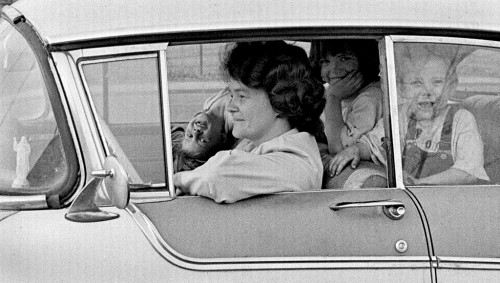 When I spotted this carload of kids shot back in Ohio in 1969, I thought back on more innocent days when we counted on plastic statues on the dashboard to keep our precious cargo safe. The only restraint system most kids encountered was Mom’s arm hastily flung out in front of them.
When I spotted this carload of kids shot back in Ohio in 1969, I thought back on more innocent days when we counted on plastic statues on the dashboard to keep our precious cargo safe. The only restraint system most kids encountered was Mom’s arm hastily flung out in front of them.
Padded dashboards
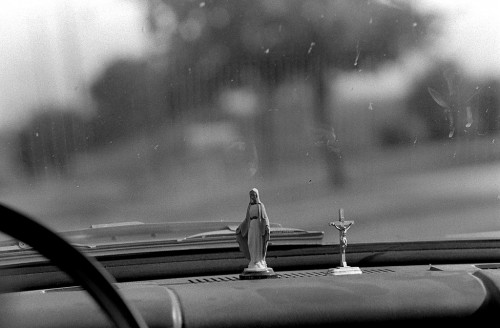 These icons would have a tough time sticking to today’s padded dashboards that replaced nose-bending metal ones.
These icons would have a tough time sticking to today’s padded dashboards that replaced nose-bending metal ones.
You can say what you want to about how “they don’t build them like they used to,” but that’s a good thing. My 2000 Odyssey van just turned over 170K miles. I used to have to trade cars about every two years when they had less than a third that much mileage. It’s true that cars suffer damage at lower speeds than they used to, but that’s because they are designed with “crumple zones” that eat up the energy of a crash rather than transmitting it to the vehicle’s occupants like the old solid-frame cars.
Seatbelts in the Buick LaSabre
My folks figured I needed more than plastic statues, particularly after I hit a bridge before I had driven 150 yards during Ernie Chiles’ attempt to teach me how to navigate the highways. They equipped the family’s 1959 Buick LaSabre station wagon with some of the first after-market seatbelts to hit the market. My car and I were covering the Buck Nelson Flying Saucer Convention in Mountain View in this photo. You’ll read more about that later.
There was nothing automatic about those first belts. In fact, I’m not even sure they had quick-release buckles; you might have had to thread the belt through the buckle every time. I don’t remember if the wide front seat had two sets of belts or three. If it was the former, that was probably Mother’s idea of safety – it kept my date on the far side of the car.
I give Dad credit: he put them in the car for me, but he wore them religiously, if only to set a good example. Working hundreds of wrecks made me a seatbelt fanatic. When I encountered a passenger who didn’t want to buckle up, I’d give them a choice: buckle up or walk. Here’s a site that gives a good explanation of why seatbelts save lives and how they work. They’ve come a long way since my fabric belt bolted to the floor.
Crash stories
- Trooper Norman Copeland
- The humanity of crashes
- Car takes out sign at Evangelical United Church of Christ
- Sports car plows into Colonial Restaurant
- First car comes to cape in 1904; first crash reported in 1910
- A bridge too small
- Fender-bender at Fountain and Broadway
- Flo’s only accident in 29 years
- Deadly Old Appleton bridge set for replacement
- Wreck at Broadway and Perry shows neighborhood changes
- Big tire smashes into car
- Train vs. truck
- Nighttime car vs pole in front of Shoe Factory
- Broadway – Pacific crash shows businesses at night
- Buick didn’t stop on icy hill
- Funeral homes provided ambulance service

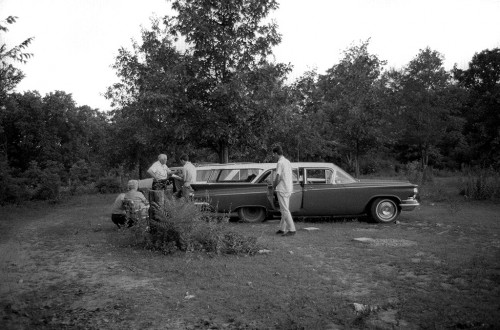
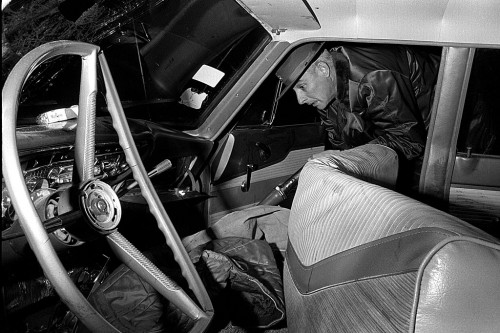
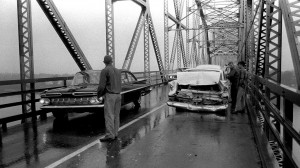
I am a seatbelt fanatic, too. I had forgotten all about the plastic Mother Mary that road on the dash of my husband’s car. I think all the Notre Dame High Schools kids had them. When we moved to Wisconsin, we noticed the only thing on people dashboards were those hula girls with moving parts. To my recollection, Mary had no moving parts, not even the halo.
What I don’t understand is the folks who think the laws of physics only apply to the back seat.
I know people – a lot of people – who put a seatbelt on every time they sit in the front seat but they never do in the back seat. That just blows my mind. As if somehow sitting four feet further back in the vehicle will magically save their life.
Cheers,
Matt
As the old song goes “I don’t care if it rains or freezes, long as I got my plastic Jesus sittin on the dashboard of my car.”
Or this . . . “I drive fast but I ain’t scary ’cause I’ve got the Virgin Mary telling me that I won’t go to hell.”
Hi Ken,
I love the image of the dashboard mary statue above!
Is there a way I can get in touch with you privately through email to see if it would be possible for me to use this image? I’m working on a chapbook of poems and texts relating to dashboards (of the car based kind but also of the city dashboard kind). This image would really compliment the texts.
Thanks in advance,
Warmest wishes,
Jessica
I’ll send you an email. I’m sure we can work something out.